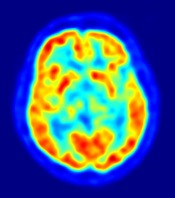 Evolution
Evolution
The Brain Remains an Evolutionary Mystery
 The brain is a mysterious thing. There is the familiar problem of how the mind and the brain relate to each other. Beyond this, a major difficulty from a Darwinian evolutionary perspective is explaining why our brains are so much more complicated than any other animal’s. Several articles have been published recently that try to fit the human brain within the grand scheme of evolutionary history.
The brain is a mysterious thing. There is the familiar problem of how the mind and the brain relate to each other. Beyond this, a major difficulty from a Darwinian evolutionary perspective is explaining why our brains are so much more complicated than any other animal’s. Several articles have been published recently that try to fit the human brain within the grand scheme of evolutionary history.
To shed light on this discrepancy in evolutionary development, scientists have compared brain development in humans and chimpanzees, both in utero and postnatal. In two papers, one in Cell and the other in PNAS Biology, researchers found that the human brain develops faster in utero; but once humans are born, the parts of the brain that allow complex interactions develop more slowly than in chimpanzee brains. In other words, while humans have, overall, more complex brains, the human brain takes longer to assume its adult form. Miller et al. suggest that this may be one of the reasons why many neurological disorders are unique to humans, another fact that is difficult to explain from an evolutionary framework.
Meanwhile, a report in Proceedings of the National Academy of Sciences suggests that brain-to-body ratio may not be a marker of greater intelligence after all, because brain size and body size may be subject to different selective pressures and therefore evolve through different mechanisms. One of the unique features of human beings is the size of our brains relative to body size, which is significantly higher than in most species. Because humans have marked intelligence and complex mental patterns, the prevailing assumption was that this ratio had something to do with the obvious neurological differences. Increasing brain size and mental capacity was the motivating factor in evolving a large brain-to-body ratio, so went the theory. However, that idea does not seem to fit with the assumed phylogenies of bats, primates, and carnivorans. It appears that body mass and brain size change at different rate and in different ways, indicating they may not be related.
In an evolutionary paradigm, you need to account for the large leap from the mental capacities of chimpanzees to humans’ advanced neurological capacities. We know that some species enjoy high cognitive abilities in their own right, chimpanzees and dolphins being two common examples. However, they still lack the profound power to create and express novel and abstract ideas. As far as studies can tell, they also lack a certain quality of self-awareness that human beings have. These recent studies may be interesting in a comparative sense, but they still do not answer the conundrum of consciousness.
Some evolutionists do not particularly care about the past as much as the evolutionary development of the human brain extending into the future. Futurist Ray Kurzweil, currently promoting his new book How to Create a Mind, believes that someday we will be able to reverse-engineer the brain, uncovering its secrets. Kurzweil acknowledges the evolutionary gap between humans and all other animals, but rather than trying to piece together the past, he thinks we should strive to understand our brain’s unique complexity in hopes of producing the next evolutionary leap in human brain capacity. PC Magazine reports on his recent speech to the Demo technology conference:
Improvements in technology such as MRI spatial resolution have led to a better understanding of how the brain works. [Kurzweil] espoused a thesis about the uniform structure of the neocortex, saying it is made up of 300 million undifferentiated “pattern recognizers” in a hierarchical structure. The difference in the amount of pattern recognizers compared with other animals is exponential, giving humans enough capability to create art, science, and literature…Techniques that evolved in the biological brain are the same that are used for things such as speech and character recognition, and they will be used to expand our brain power.
These notions remind you somewhat of the research methods of biomimicry, a discipline in which scientists look to nature for engineering ideas. But unlike biomimicry, Kurzweil’s theories are the other side of the coin of evolutionary biologist’s theories. He hopes to understand human evolution so that humans can acquire a superhuman intelligence, while most evolutionary biologists hope to reconstruct human evolution to better understand our origins.
Both, however, take as a fundamental assumption a certain kind of reductionism in which the human brain is understood to have evolved unguided, through natural selection, from a simple to a more complex structure. Even though we have yet to explain exactly how this happened, both assume that it must have done so, evidence to the contrary notwithstanding.
Image credit: PET image of the human brain showing energy consumption/Wikipedia.
